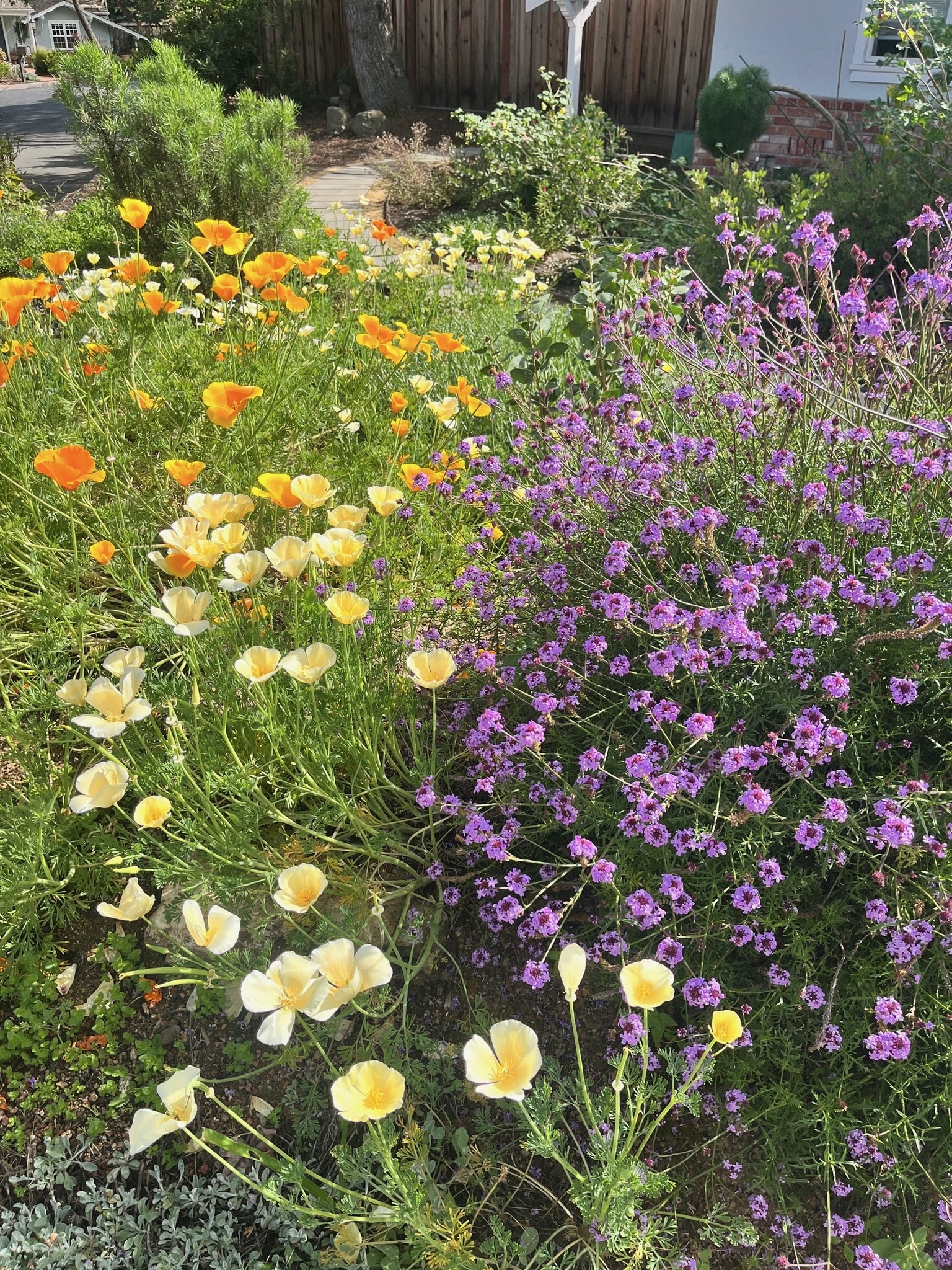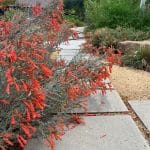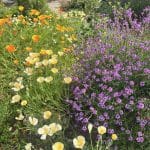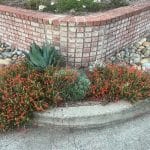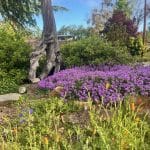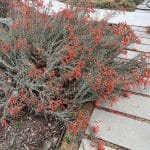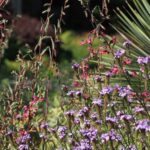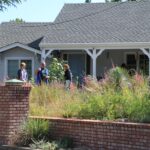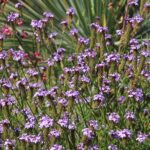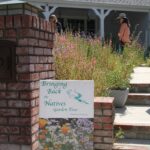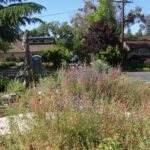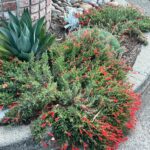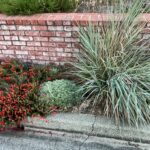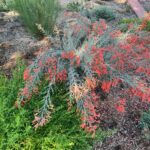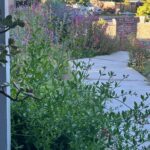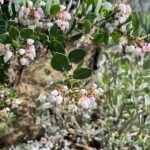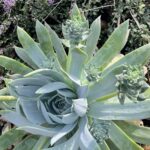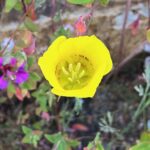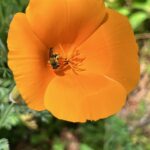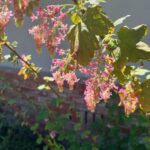Showcase Feature
The large lawn that covered this spacious corner lot when Glenn and David purchased the house in 2021 didn’t last long. Glenn, Executive Director of the Golden Gate Bird Alliance, envisioned a garden that would be beautiful, low-maintenance, and nearly self-sufficient once established—thriving without pesticides and providing essential food, shelter, and nesting areas for birds. Glenn sheet-mulched away the lawn, and together with John Bain of Mariposa Garden Design, created the garden that now flourishes here.
 The entrance is framed by berms that come alive each spring with native annuals including clarkia, phacelia, and lupine, along with both wild-type and cream-colored “Moonglow” poppies. Interspersed among these annuals are native bulbs such as blue dicks, wild onions, Ithuriel’s Spear, Brodiaea, and camas, which add seasonal bursts of color and texture. This year, the collection of Dudleyas and Lewisias was moved into a shadier spot closer to the house to protect them from the intense summer sun, where they are joined by a particularly Dr. Zeussian giant Coreopsis, and other coastal plants.
The entrance is framed by berms that come alive each spring with native annuals including clarkia, phacelia, and lupine, along with both wild-type and cream-colored “Moonglow” poppies. Interspersed among these annuals are native bulbs such as blue dicks, wild onions, Ithuriel’s Spear, Brodiaea, and camas, which add seasonal bursts of color and texture. This year, the collection of Dudleyas and Lewisias was moved into a shadier spot closer to the house to protect them from the intense summer sun, where they are joined by a particularly Dr. Zeussian giant Coreopsis, and other coastal plants.
The meadow in front of the living room window—designed to preserve the open view—features lush, fine-bladed Point Molate red fescue and blue grama grass. Although the alkali sacaton looks unassuming in spring, its silvery-green leaves and reddish-purple seed heads add grace in late summer. In the warm months, California fuchsia roars into bloom, delighting the many Anna’s hummingbirds that frequent the garden. The sweet scent of hummingbird sage drifts through the air, and a redwood burl and boulders add sculptural interest.
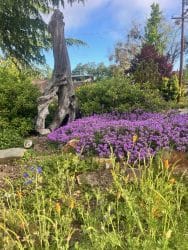 Around the garden, seven varieties of manzanita (‘Dr. Hurd’, ‘John Dourley’, ‘Sunset’, ‘Shatterberry’, ‘Baby Bear’, ‘Point Arena’, and ‘Monterey Carpet’) provide year-round structure, their burgundy bark and evergreen leaves contrasting beautifully with the blue, fragrant blooms of California lilacs (‘Concha’, ‘Yankee Point’, and ‘Joyce Coulter’). Along the street, blue-green blades of ‘Canyon Prince’ wild rye, coastal sagebrush, chalk Dudleya and the soft gray foliage of ‘Everett’s Choice’ California fuchsia complement these shrubs. Penstemons and yarrows brighten the garden while the slower-growing natives continue to fill in..
Around the garden, seven varieties of manzanita (‘Dr. Hurd’, ‘John Dourley’, ‘Sunset’, ‘Shatterberry’, ‘Baby Bear’, ‘Point Arena’, and ‘Monterey Carpet’) provide year-round structure, their burgundy bark and evergreen leaves contrasting beautifully with the blue, fragrant blooms of California lilacs (‘Concha’, ‘Yankee Point’, and ‘Joyce Coulter’). Along the street, blue-green blades of ‘Canyon Prince’ wild rye, coastal sagebrush, chalk Dudleya and the soft gray foliage of ‘Everett’s Choice’ California fuchsia complement these shrubs. Penstemons and yarrows brighten the garden while the slower-growing natives continue to fill in..
Other Garden Attractions
• Browse the “Plants for Birds” exhibit featuring hardy, easy-to-grow native species that provide food and habitat while thriving in local conditions.
• Check out the bird-safe windows, treated with external markers to help birds recognize the glass. Every year, about one billion birds in the U.S. die from window collisions—often at our homes. You can help prevent these deaths by adding markers to your own windows. Feather Friendly offers a 10% discount for Tour visitors with code BBNG2026. Find out more here.)
• Take a seat, listen to the birds, and enjoy the serenity—many visitors find it hard to leave.
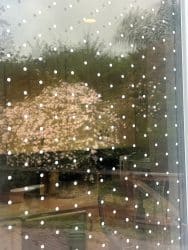 • Check out the bird-safe windows, which have markers on the outside of the glass so birds can see it. Did you know that one billion birds in the U.S. die each year by flying into glass—and this often happens at our homes? You can prevent bird / glass collision deaths at your house or workplace by applying these markers to the exteriors of your windows. Feather Friendly has offered a 10% discount to Tour fans. Just use the discount code BBNG2025, and help prevent this #2 direct cause of bird mortality.
• Check out the bird-safe windows, which have markers on the outside of the glass so birds can see it. Did you know that one billion birds in the U.S. die each year by flying into glass—and this often happens at our homes? You can prevent bird / glass collision deaths at your house or workplace by applying these markers to the exteriors of your windows. Feather Friendly has offered a 10% discount to Tour fans. Just use the discount code BBNG2025, and help prevent this #2 direct cause of bird mortality.
• Take a seat in this peaceful garden and listen to the birds; you won’t want to leave!
Gardening for Wildlife
Interestingly, there are no feeders in this garden—Glenn prefers to “feed the birds with his plants.” The results speak for themselves: cedar waxwings, band-tailed pigeons, California towhees, and oak titmice are regulars. Great horned owls call to one another in the evenings, and a California quail was recently spotted—a thrilling first! Bushtits, oak titmice, lesser goldfinches, and Bewick’s wrens have all nested here. The meadow provides shelter for grassland birds, and rock piles offer refuge for lizards.
Green Home Features 
This home contains solar panels, a heat pump for heating and cooling the house, This home integrates sustainability inside and out, with:
• solar panels
• a heat pump for heating and cooling, and
• an electric vehicle and charger
all helping reduce the household’s environmental footprint.
Keystone species (watch this talk by Doug Tallamy!)
Keystone species—our own, local ecological powerhouse plants—in this garden include valley oak, currant, California lilac, manzanita, sage, coyote brush, snowberry, and penstemon.
At least partially wheelchair accessible? Yes
Photos
Click to see as a slideshow:
- Arctostaphylos edmundsii

